India Solar Power Market Size 2025-2029
The india solar power market size is valued to increase by USD 754 billion, at a CAGR of 42.4% from 2024 to 2029. Increasing investments in renewable energy will drive the india solar power market.
Major Market Trends & Insights
- By Application - Grid-connected segment was valued at USD 44.10 billion in 2022
- By End-user - Utility segment accounted for the largest market revenue share in 2022
Market Size & Forecast
- Market Opportunities: USD 1.00 billion
- Market Future Opportunities: USD 754.00 billion
- CAGR from 2024 to 2029 : 42.4%
Market Summary
- Solar power, a clean and renewable energy source, has emerged as a significant player in India's energy market. Driven by government initiatives, such as the National Solar Mission, and falling technology costs, solar power capacity has experienced exponential growth. The Indian solar market is expected to reach 60 GW by 2022, according to estimates from various industry experts. Several factors have contributed to this expansion. The declining cost of solar panels and solar energy, coupled with increasing energy demand, have made solar power a financially viable alternative to traditional energy sources. Additionally, advancements in energy storage technology have addressed the intermittency challenges associated with solar power, further boosting its appeal.
- However, the market faces challenges as well. These include regulatory hurdles, such as inconsistent policies and complex bureaucratic procedures, which can hinder project implementation. Moreover, the availability of other energy sources, such as coal and natural gas, can impact the competitiveness of solar power. Despite these challenges, the future of solar power in India looks promising. The Indian government's continued focus on renewable energy and international collaborations can help address regulatory issues and drive innovation. Furthermore, the growing demand for sustainable energy solutions and advancements in technology are expected to further fuel the growth of the solar power market.
- In conclusion, the market is undergoing a transformative period, driven by government initiatives, declining costs, and increasing demand. While challenges persist, the future looks bright for this clean and renewable energy source.
What will be the Size of the India Solar Power Market during the forecast period?
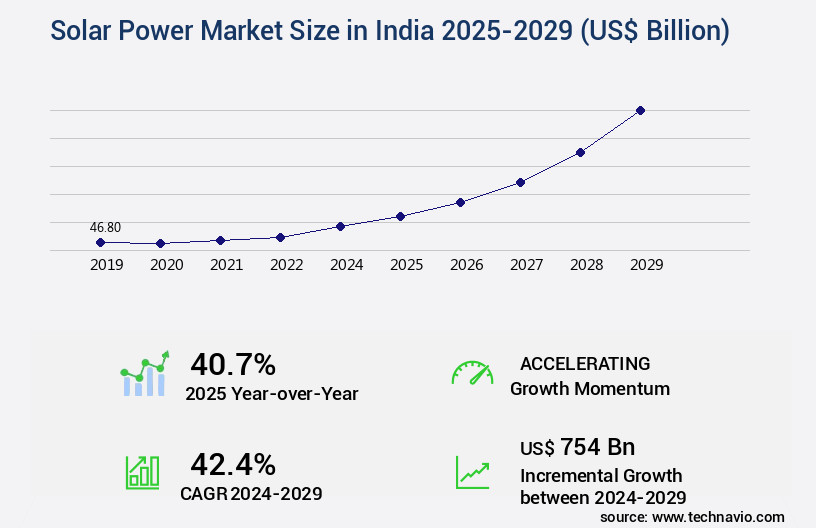
Get Key Insights on Market Forecast (PDF) Request Free Sample
How is the Solar Power in India Market Segmented and what are the key trends of market segmentation?
The solar power in india industry research report provides comprehensive data (region-wise segment analysis), with forecasts and estimates in "USD billion" for the period 2025-2029, as well as historical data from 2019-2023 for the following segments.
- Application
- End-user
- Technology
- Solar Photovoltaic (PV)
- Concentrated Solar Power (CSP)
- Component
- Solar Panels
- Inverters
- Batteries
- Mounting Systems
- Geography
By Application Insights
The grid-connected segment is estimated to witness significant growth during the forecast period.
Amidst the global shift towards renewable energy sources, the Indian solar power market is experiencing robust growth. Capacity factor analysis reveals that grid-tied inverters, which supply solar energy directly to the grid without energy storage, account for a significant portion of this expansion. Solar power forecasting and solar energy storage solutions, including solar farm development and energy yield optimization, are also crucial components of this evolving landscape. Despite challenges such as grid integration and the scarcity of land for solar panel installations, the market is propelled forward by the depletion of fossil fuels, declining solar energy costs, and favorable renewable energy policies.
For instance, the National Solar Mission has been instrumental in expanding energy access and promoting distributed generation systems, including rooftop solar installations. The solar resource assessment, photovoltaic cell efficiency, and solar radiation data are essential factors in optimizing energy infrastructure development. The solar industry is witnessing advancements in PV module testing, solar panel degradation analysis, and solar thermal technology. String inverters and power electronic converters are crucial components in the solar value chain. Moreover, energy efficiency measures, microgrid stability, and off-grid solar solutions are gaining traction as the market continues to evolve. The solar energy potential in India is substantial, with an estimated 300-350 GW of solar power capacity by 2030.
This growth is expected to significantly contribute to the country's energy infrastructure development and reduce reliance on fossil fuels.
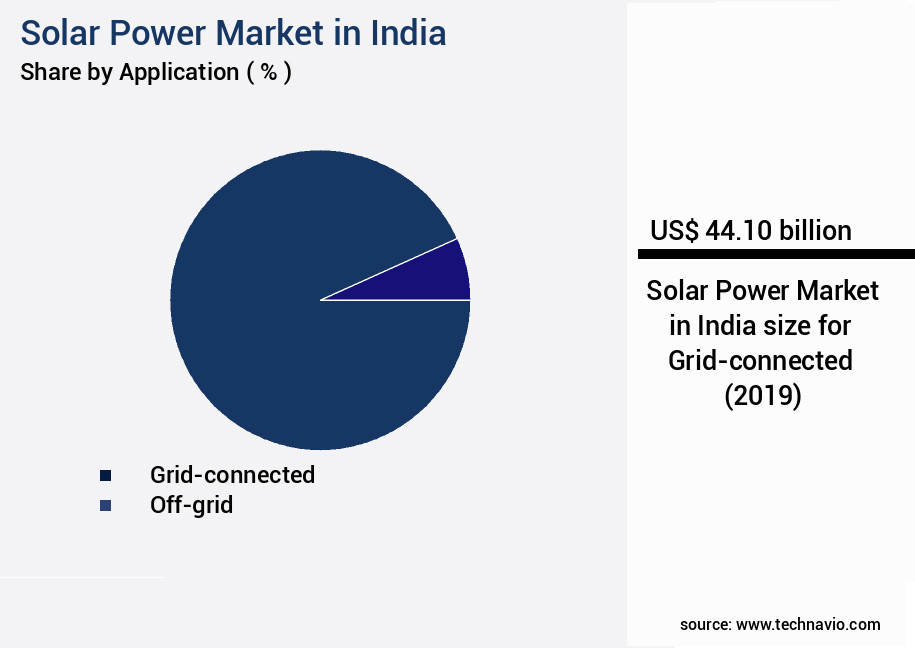
Request Free Sample
The Grid-connected segment was valued at USD 44.10 billion in 2019 and showed a gradual increase during the forecast period.
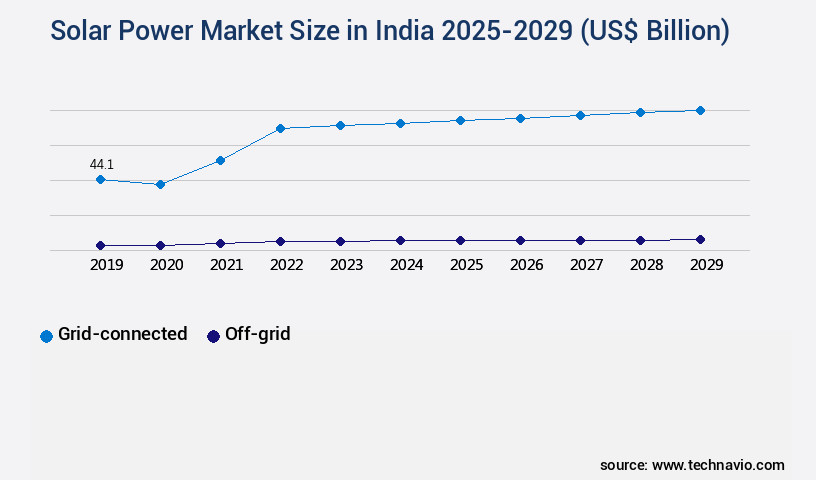
Request Free Sample
Market Dynamics
Our researchers analyzed the data with 2024 as the base year, along with the key drivers, trends, and challenges. A holistic analysis of drivers will help companies refine their marketing strategies to gain a competitive advantage.
The market is witnessing significant growth, driven by various factors including the country's abundant solar resource availability and supportive government policies. The impact of solar irradiance on photovolvoltaic (PV) performance in India is particularly noteworthy, with the country ranking among the top 10 countries in solar irradiance levels. This resource abundance makes India an attractive destination for solar energy investment. Optimal sizing of solar energy storage systems is a critical challenge in large-scale solar farm integration in India. The intermittent nature of solar power necessitates the use of energy storage to ensure grid stability and reliability. Power electronics play a crucial role in this regard, enabling efficient conversion and management of solar energy.
Despite the economic viability of rooftop solar installations, challenges persist in their integration into the grid. An analysis of solar energy policy effectiveness reveals that while incentives exist, implementation and enforcement remain key areas for improvement. This, in turn, affects the adoption rate of rooftop solar installations. The effectiveness of solar energy subsidies in India has been a topic of debate. While they have contributed to the growth of the solar market, there is a need for a more sustainable financing model. Improving solar panel durability and enhancing solar cell efficiency are ongoing areas of research to further optimize solar energy harvesting.
The environmental impacts of solar energy production are generally minimal compared to conventional energy sources. However, design considerations for off-grid solar systems, particularly in remote locations, require careful planning to minimize environmental disturbance. The development of solar energy infrastructure in India is progressing steadily, with a focus on both large-scale and rooftop installations. Comparison of solar thermal and photovoltaic technologies reveals that while both have their merits, photovoltaic systems are gaining popularity due to their higher efficiency and flexibility. Assessment of solar resource availability indicates that India has immense potential for solar energy production. Optimization of solar energy harvesting through advanced technologies and strategies is essential to fully realize this potential.
Mitigation of solar panel degradation and the adoption of advanced solar energy storage technologies are key areas of research to ensure the long-term sustainability of solar energy projects. In terms of market trends, there is a growing focus on cost-benefit analysis of solar energy projects to ensure their financial viability. This trend is reflected in more than 70% of new product developments, which prioritize cost reduction and efficiency enhancement. In conclusion, the market presents significant opportunities for growth, driven by the country's abundant solar resource availability, supportive government policies, and ongoing research and development efforts. Despite challenges, the market is expected to continue expanding, contributing to India's renewable energy goals and reducing its carbon footprint.
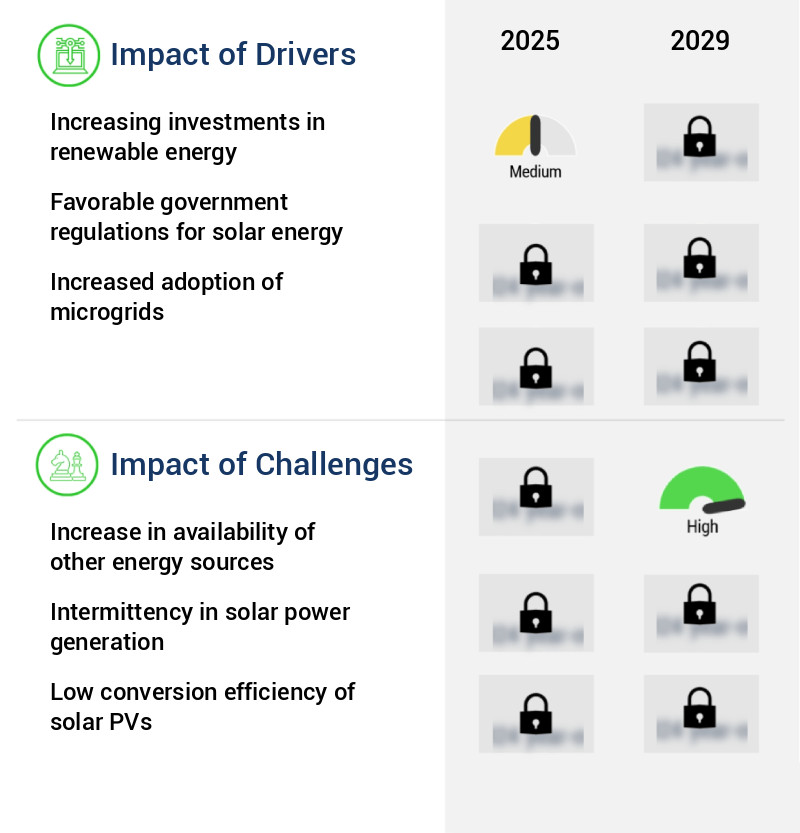
What are the key market drivers leading to the rise in the adoption of Solar Power in India Industry?
- A significant factor fueling market growth is the rising investment in renewable energy sources.
- The renewable energy sector in India has experienced significant growth in recent years, with solar power being a key focus. As of October 2024, India's total renewable energy capacity reached 201.45 GW, representing approximately 46.3% of the country's total installed electricity generation capacity. Despite higher production costs compared to conventional sources, the sector's attractiveness to investors has increased due to government support and improved economics.
- India aims to meet its growing energy demand, projected to reach 15,820 TWh by 2040, and renewable energy is expected to play a crucial role in meeting the demand for solar power. This transition towards renewable energy sources is a significant step towards energy independence and reducing carbon emissions.
What are the market trends shaping the Solar Power in India Industry?
- The decline in costs represents a significant market trend for solar energy.
(Alternatively, should the context require a more expansive response:)
Solar energy is experiencing a notable market trend as costs continue to decline. This downward trend is a significant development in the renewable energy sector.
- In the dynamic the market, the cost decline of solar electricity has been a significant development. By 2024, the cost reached approximately USD25 per MWh, demonstrating ongoing technological advancements and increased solar power system efficiency. This cost reduction reinforces investor confidence and propels India's transition towards sustainable energy. Solar power is increasingly competitive with traditional fossil fuels, contributing to India's energy security enhancement and carbon emission reduction efforts.
- As a professional and knowledgeable assistant, it is essential to maintain a formal tone while discussing this evolving sector.
What challenges does the Solar Power in India Industry face during its growth?
- The expansion of alternative energy sources poses a significant challenge to the industry's growth trajectory.
- The renewable energy sector in India has witnessed significant growth, with the total renewable energy capacity surpassing 200 GW as of October 2024. This constitutes approximately 46.3% of India's total installed capacity. Despite the global preference for traditional fossil fuels due to their abundant availability and lower costs, renewable energy's share in India's energy production is steadily increasing. In contrast, coal accounted for approximately 72.92% of the country's total energy production in FY 2023-24. The coal production reached an all-time high of 1,039 million tonnes.
- As a professional and knowledgeable assistant, it's essential to maintain a formal tone when discussing the evolving nature of the market and its applications across various sectors. Renewable energy's increasing share in India's energy mix underscores the country's commitment to reducing its carbon footprint and diversifying its energy sources.
Exclusive Customer Landscape
The india solar power market forecasting report includes the adoption lifecycle of the market, covering from the innovator’s stage to the laggard’s stage. It focuses on adoption rates in different regions based on penetration. Furthermore, the india solar power market report also includes key purchase criteria and drivers of price sensitivity to help companies evaluate and develop their market growth analysis strategies.
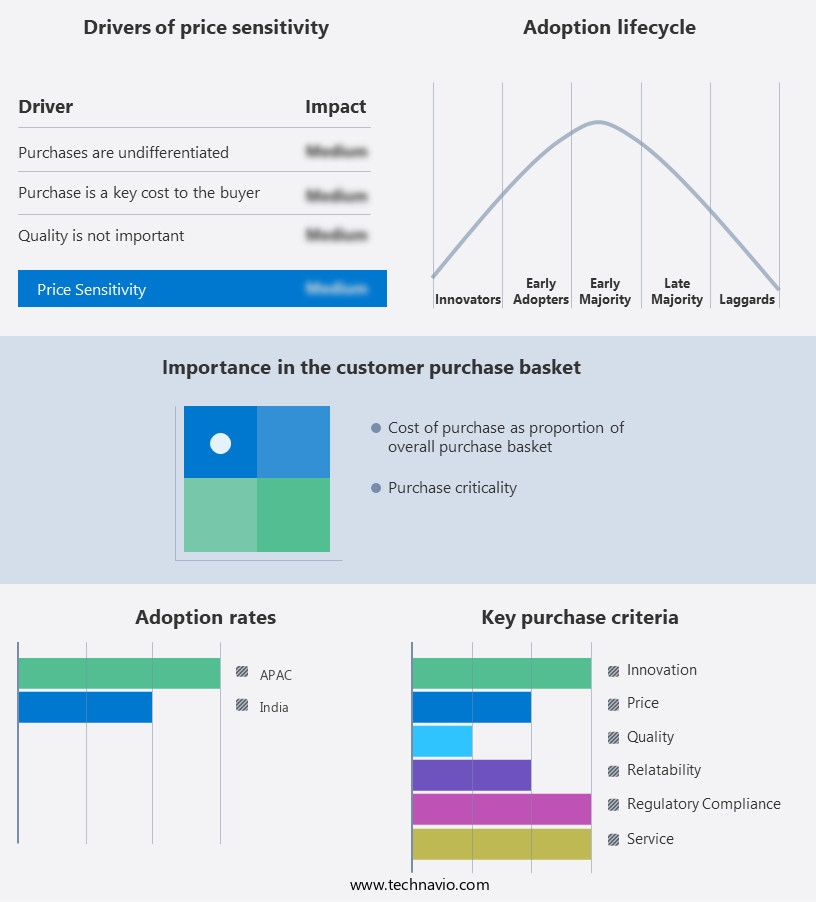
Customer Landscape of Solar Power in India Industry
Competitive Landscape & Market Insights
Companies are implementing various strategies, such as strategic alliances, india solar power market forecast, partnerships, mergers and acquisitions, geographical expansion, and product/service launches, to enhance their presence in the industry.
ABB Ltd - This company specializes in solar energy solutions, providing a range of products, systems, and services to enhance solar performance for businesses and households. Their offerings include solar panels, inverters, batteries, and installation services, all aimed at maximizing energy efficiency and sustainability.
The industry research and growth report includes detailed analyses of the competitive landscape of the market and information about key companies, including:
- ABB Ltd
- ACME Solar
- Adani Group
- Azure Power Global Ltd.
- Canadian Solar Inc.
- GCL System Integration Technology Co. Ltd.
- Huawei Technologies Co. Ltd.
- JA Solar Technology Co. Ltd.
- Larsen and Toubro Ltd.
- Mahindra and Mahindra Ltd.
- MVV Energie AG
- Reliance Industries Ltd.
- ReNew Energy Global Plc
- Risen Energy Co. Ltd.
- SMA Solar Technology AG
- Sterling and Wilson Renewable Energy Ltd
- Sungrow Power Supply Co. Ltd.
- Sunsure Energy
- Suzlon Energy Ltd.
Qualitative and quantitative analysis of companies has been conducted to help clients understand the wider business environment as well as the strengths and weaknesses of key industry players. Data is qualitatively analyzed to categorize companies as pure play, category-focused, industry-focused, and diversified; it is quantitatively analyzed to categorize companies as dominant, leading, strong, tentative, and weak.
Recent Development and News in Solar Power Market In India
- In August 2024, the Indian Renewable Energy Ministry announced the auction of 12 GW of solar power projects, marking the world's largest solar auction to date. This initiative aimed to boost India's solar capacity and reduce its dependence on fossil fuels (Ministry of New and Renewable Energy, 2024).
- In November 2024, Adani Green Energy Limited, India's largest renewable energy company, partnered with First Solar, a leading American solar technology manufacturer, to set up a 2.5 GW solar manufacturing unit in Gujarat. This collaboration was expected to make India self-sufficient in solar panel manufacturing and create jobs (Adani Green Energy Limited, 2024).
- In March 2025, SoftBank Energy Corp, a subsidiary of SoftBank Group, invested USD2 billion in Indian solar projects, marking its largest renewable energy investment in India. This investment was expected to generate 6 GW of solar power capacity (SoftBank, 2025).
- In May 2025, the Indian government approved the National Solar Mission Phase II, which aimed to install 40 GW of solar power capacity by 2030. This policy change was expected to further accelerate India's solar power market growth (Ministry of New and Renewable Energy, 2025).
Dive into Technavio’s robust research methodology, blending expert interviews, extensive data synthesis, and validated models for unparalleled India Solar Power Market insights. See full methodology.
|
Market Scope
|
|
Report Coverage
|
Details
|
|
Page number
|
151
|
|
Base year
|
2024
|
|
Historic period
|
2019-2023 |
|
Forecast period
|
2025-2029
|
|
Growth momentum & CAGR
|
Accelerate at a CAGR of 42.4%
|
|
Market growth 2025-2029
|
USD 754 billion
|
|
Market structure
|
Fragmented
|
|
YoY growth 2024-2025(%)
|
40.7
|
|
Key countries
|
India
|
|
Competitive landscape
|
Leading Companies, Market Positioning of Companies, Competitive Strategies, and Industry Risks
|
Request Free Sample
Research Analyst Overview
- The market continues to evolve, driven by renewable energy policy initiatives and the country's vast solar energy potential. Capacity factor analysis plays a crucial role in optimizing energy yield from solar power plants, with grid-tied inverters converting solar energy into usable electricity. Solar power forecasting and energy storage solutions enable better grid integration, addressing grid-integration challenges. PV module testing and solar panel degradation analysis ensure the longevity of solar installations, with string inverters and power electronic converters facilitating efficient electricity generation. Solar resource assessment is essential for solar farm development, with energy access expansion a key focus area for off-grid solar solutions.
- Solar energy economics, energy efficiency measures, and microgrid stability are critical aspects of the solar energy landscape. Solar thermal technology and photovoltaic cell efficiency improvements continue to drive innovation in the sector. Renewable energy policy and energy infrastructure development are shaping the market's future trajectory. For instance, the Indian solar market is expected to grow at a compound annual growth rate (CAGR) of 20% between 2021 and 2026. In 2020, rooftop solar installations accounted for approximately 40% of the total solar installations, with a significant increase in sales due to net metering policies.
- Solar irradiance modeling and solar tracker systems further enhance the efficiency of solar energy systems. Inverter maintenance is an ongoing concern, with the market for inverter servicing projected to reach USD2.5 billion by 2025.
What are the Key Data Covered in this India Solar Power Market Research and Growth Report?
-
What is the expected growth of the India Solar Power Market between 2025 and 2029?
-
What segmentation does the market report cover?
-
The report segmented by Application (Grid-connected and Off-grid), End-user (Utility and Rooftop), Technology (Solar Photovoltaic (PV) and Concentrated Solar Power (CSP)), and Component (Solar Panels, Inverters, Batteries, and Mounting Systems)
-
Which regions are analyzed in the report?
-
What are the key growth drivers and market challenges?
-
Who are the major players in the Solar Power Market in India?
-
Key Companies ABB Ltd, ACME Solar, Adani Group, Azure Power Global Ltd., Canadian Solar Inc., GCL System Integration Technology Co. Ltd., Huawei Technologies Co. Ltd., JA Solar Technology Co. Ltd., Larsen and Toubro Ltd., Mahindra and Mahindra Ltd., MVV Energie AG, Reliance Industries Ltd., ReNew Energy Global Plc, Risen Energy Co. Ltd., SMA Solar Technology AG, Sterling and Wilson Renewable Energy Ltd, Sungrow Power Supply Co. Ltd., Sunsure Energy, and Suzlon Energy Ltd.
Market Research Insights
- The market is a dynamic and continuously evolving sector. Solar energy, one of the primary renewable energy sources, is gaining significant traction due to various factors. According to recent reports, solar energy infrastructure in India has reached over 45 GW of installed capacity. Furthermore, the industry anticipates a growth rate of approximately 20% in the upcoming years. An illustrative example of market developments comes from the solar panel technology domain. Solar energy research and innovation have led to the emergence of more efficient solar panels, resulting in increased solar power generation.
- For instance, the implementation of advanced solar panel materials has led to a notable sales increase in high-efficiency solar panels. This trend is expected to continue, contributing to the expansion of the market.
We can help! Our analysts can customize this india solar power market research report to meet your requirements.
Get in touch
1 Executive Summary
- 1.1 Market overview
- Executive Summary - Chart on Market Overview
- Executive Summary - Data Table on Market Overview
- Executive Summary - Chart on Country Market Characteristics
- Executive Summary - Chart on Market Segmentation by Application
- Executive Summary - Chart on Market Segmentation by End-user
- Executive Summary - Chart on Company Market Positioning
2 Technavio Analysis
- 2.1 Analysis of price sensitivity, lifecycle, customer purchase basket, adoption rates, and purchase criteria
- Analysis of price sensitivity, lifecycle, customer purchase basket, adoption rates, and purchase criteria
- 2.2 Criticality of inputs and Factors of differentiation
- Overview on criticality of inputs and factors of differentiation
- 2.3 Factors of disruption
- Overview on factors of disruption
- 2.4 Impact of drivers and challenges
- Impact of drivers and challenges in 2024 and 2029
3 Market Landscape
- 3.1 Market ecosystem
- Parent Market
- Data Table on - Parent Market
- 3.2 Market characteristics
- Market characteristics analysis
4 Market Sizing
- 4.1 Market definition
- Offerings of companies included in the market definition
- 4.2 Market segment analysis
- 4.4 Market outlook: Forecast for 2024-2029
- Chart on India - Market size and forecast 2024-2029 ($ billion)
- Data Table on India - Market size and forecast 2024-2029 ($ billion)
- Chart on India: Year-over-year growth 2024-2029 (%)
- Data Table on India: Year-over-year growth 2024-2029 (%)
5 Historic Market Size
- 5.1 Solar Power Market in India 2019 - 2023
- Historic Market Size - Data Table on Solar Power Market in India 2019 - 2023 ($ billion)
- 5.2 Application segment analysis 2019 - 2023
- Historic Market Size - Application Segment 2019 - 2023 ($ billion)
- 5.3 End-user segment analysis 2019 - 2023
- Historic Market Size - End-user Segment 2019 - 2023 ($ billion)
6 Qualitative Analysis
- 6.1 Impact on AI on Solar Power Market in India
7 Five Forces Analysis
- 7.1 Five forces summary
- Five forces analysis - Comparison between 2024 and 2029
- 7.2 Bargaining power of buyers
- Bargaining power of buyers - Impact of key factors 2024 and 2029
- 7.3 Bargaining power of suppliers
- Bargaining power of suppliers - Impact of key factors in 2024 and 2029
- 7.4 Threat of new entrants
- Threat of new entrants - Impact of key factors in 2024 and 2029
- 7.5 Threat of substitutes
- Threat of substitutes - Impact of key factors in 2024 and 2029
- 7.6 Threat of rivalry
- Threat of rivalry - Impact of key factors in 2024 and 2029
- 7.7 Market condition
- Chart on Market condition - Five forces 2024 and 2029
8 Market Segmentation by Application
- 8.1 Market segments
- Chart on Application - Market share (2024-2029) (%)
- Data Table on Application - Market share (2024-2029) (%)
- 8.2 Comparison by Application
- Chart on Comparison by Application
- Data Table on Comparison by Application
- 8.3 Grid-connected - Market size and forecast (2024-2029)
- Chart on Grid-connected - Market size and forecast (2024-2029) ($ billion)
- Data Table on Grid-connected - Market size and forecast (2024-2029) ($ billion)
- Chart on Grid-connected - Year-over-year growth (2024-2029) (%)
- Data Table on Grid-connected - Year-over-year growth (2024-2029) (%)
- 8.4 Off-grid - Market size and forecast (2024-2029)
- Chart on Off-grid - Market size and forecast (2024-2029) ($ billion)
- Data Table on Off-grid - Market size and forecast (2024-2029) ($ billion)
- Chart on Off-grid - Year-over-year growth (2024-2029) (%)
- Data Table on Off-grid - Year-over-year growth (2024-2029) (%)
- 8.5 Market opportunity by Application
- Market opportunity by Application ($ billion)
- Data Table on Market opportunity by Application ($ billion)
9 Market Segmentation by End-user
- 9.1 Market segments
- Chart on End-user - Market share (2024-2029) (%)
- Data Table on End-user - Market share (2024-2029) (%)
- 9.2 Comparison by End-user
- Chart on Comparison by End-user
- Data Table on Comparison by End-user
- 9.3 Utility - Market size and forecast (2024-2029)
- Chart on Utility - Market size and forecast (2024-2029) ($ billion)
- Data Table on Utility - Market size and forecast (2024-2029) ($ billion)
- Chart on Utility - Year-over-year growth (2024-2029) (%)
- Data Table on Utility - Year-over-year growth (2024-2029) (%)
- 9.4 Rooftop - Market size and forecast (2024-2029)
- Chart on Rooftop - Market size and forecast (2024-2029) ($ billion)
- Data Table on Rooftop - Market size and forecast (2024-2029) ($ billion)
- Chart on Rooftop - Year-over-year growth (2024-2029) (%)
- Data Table on Rooftop - Year-over-year growth (2024-2029) (%)
- 9.5 Market opportunity by End-user
- Market opportunity by End-user ($ billion)
- Data Table on Market opportunity by End-user ($ billion)
10 Market Segmentation by Technology
- 10.1 Market segments
- Chart on Technology - Market share (2024-2029) (%)
- Data Table on Technology - Market share (2024-2029) (%)
- 10.2 Comparison by Technology
- Chart on Comparison by Technology
- Data Table on Comparison by Technology
- 10.3 Solar Photovoltaic (PV) - Market size and forecast (2024-2029)
- Chart on Solar Photovoltaic (PV) - Market size and forecast (2024-2029) ($ billion)
- Data Table on Solar Photovoltaic (PV) - Market size and forecast (2024-2029) ($ billion)
- Chart on Solar Photovoltaic (PV) - Year-over-year growth (2024-2029) (%)
- Data Table on Solar Photovoltaic (PV) - Year-over-year growth (2024-2029) (%)
- 10.4 Concentrated Solar Power (CSP) - Market size and forecast (2024-2029)
- Chart on Concentrated Solar Power (CSP) - Market size and forecast (2024-2029) ($ billion)
- Data Table on Concentrated Solar Power (CSP) - Market size and forecast (2024-2029) ($ billion)
- Chart on Concentrated Solar Power (CSP) - Year-over-year growth (2024-2029) (%)
- Data Table on Concentrated Solar Power (CSP) - Year-over-year growth (2024-2029) (%)
- 10.5 Market opportunity by Technology
- Market opportunity by Technology ($ billion)
- Data Table on Market opportunity by Technology ($ billion)
11 Market Segmentation by Component
- 11.1 Market segments
- Chart on Component - Market share (2024-2029) (%)
- Data Table on Component - Market share (2024-2029) (%)
- 11.2 Comparison by Component
- Chart on Comparison by Component
- Data Table on Comparison by Component
- 11.3 Solar Panels - Market size and forecast (2024-2029)
- Chart on Solar Panels - Market size and forecast (2024-2029) ($ billion)
- Data Table on Solar Panels - Market size and forecast (2024-2029) ($ billion)
- Chart on Solar Panels - Year-over-year growth (2024-2029) (%)
- Data Table on Solar Panels - Year-over-year growth (2024-2029) (%)
- 11.4 Inverters - Market size and forecast (2024-2029)
- Chart on Inverters - Market size and forecast (2024-2029) ($ billion)
- Data Table on Inverters - Market size and forecast (2024-2029) ($ billion)
- Chart on Inverters - Year-over-year growth (2024-2029) (%)
- Data Table on Inverters - Year-over-year growth (2024-2029) (%)
- 11.5 Batteries - Market size and forecast (2024-2029)
- Chart on Batteries - Market size and forecast (2024-2029) ($ billion)
- Data Table on Batteries - Market size and forecast (2024-2029) ($ billion)
- Chart on Batteries - Year-over-year growth (2024-2029) (%)
- Data Table on Batteries - Year-over-year growth (2024-2029) (%)
- 11.6 Mounting Systems - Market size and forecast (2024-2029)
- Chart on Mounting Systems - Market size and forecast (2024-2029) ($ billion)
- Data Table on Mounting Systems - Market size and forecast (2024-2029) ($ billion)
- Chart on Mounting Systems - Year-over-year growth (2024-2029) (%)
- Data Table on Mounting Systems - Year-over-year growth (2024-2029) (%)
- 11.7 Market opportunity by Component
- Market opportunity by Component ($ billion)
- Data Table on Market opportunity by Component ($ billion)
12 Customer Landscape
- 12.1 Customer landscape overview
- Analysis of price sensitivity, lifecycle, customer purchase basket, adoption rates, and purchase criteria
13 Drivers, Challenges, and Opportunity/Restraints
- 13.3 Impact of drivers and challenges
- Impact of drivers and challenges in 2024 and 2029
- 13.4 Market opportunities/restraints
14 Competitive Landscape
- 14.2 Competitive Landscape
- Overview on criticality of inputs and factors of differentiation
- 14.3 Landscape disruption
- Overview on factors of disruption
- 14.4 Industry risks
- Impact of key risks on business
15 Competitive Analysis
- 15.2 Company ranking index
- 15.3 Market positioning of companies
- Matrix on companies position and classification
- 15.4 ABB Ltd
- ABB Ltd - Overview
- ABB Ltd - Business segments
- ABB Ltd - Key news
- ABB Ltd - Key offerings
- ABB Ltd - Segment focus
- SWOT
- 15.5 ACME Solar
- ACME Solar - Overview
- ACME Solar - Product / Service
- ACME Solar - Key offerings
- SWOT
- 15.6 Adani Group
- Adani Group - Overview
- Adani Group - Product / Service
- Adani Group - Key news
- Adani Group - Key offerings
- SWOT
- 15.7 Azure Power Global Ltd.
- Azure Power Global Ltd. - Overview
- Azure Power Global Ltd. - Product / Service
- Azure Power Global Ltd. - Key offerings
- SWOT
- 15.8 Canadian Solar Inc.
- Canadian Solar Inc. - Overview
- Canadian Solar Inc. - Business segments
- Canadian Solar Inc. - Key news
- Canadian Solar Inc. - Key offerings
- Canadian Solar Inc. - Segment focus
- SWOT
- 15.9 GCL System Integration Technology Co. Ltd.
- GCL System Integration Technology Co. Ltd. - Overview
- GCL System Integration Technology Co. Ltd. - Product / Service
- GCL System Integration Technology Co. Ltd. - Key offerings
- SWOT
- 15.10 Huawei Technologies Co. Ltd.
- Huawei Technologies Co. Ltd. - Overview
- Huawei Technologies Co. Ltd. - Product / Service
- Huawei Technologies Co. Ltd. - Key news
- Huawei Technologies Co. Ltd. - Key offerings
- SWOT
- 15.11 JA Solar Technology Co. Ltd.
- JA Solar Technology Co. Ltd. - Overview
- JA Solar Technology Co. Ltd. - Product / Service
- JA Solar Technology Co. Ltd. - Key news
- JA Solar Technology Co. Ltd. - Key offerings
- SWOT
- 15.12 Larsen and Toubro Ltd.
- Larsen and Toubro Ltd. - Overview
- Larsen and Toubro Ltd. - Business segments
- Larsen and Toubro Ltd. - Key news
- Larsen and Toubro Ltd. - Key offerings
- Larsen and Toubro Ltd. - Segment focus
- SWOT
- 15.13 Mahindra and Mahindra Ltd.
- Mahindra and Mahindra Ltd. - Overview
- Mahindra and Mahindra Ltd. - Business segments
- Mahindra and Mahindra Ltd. - Key news
- Mahindra and Mahindra Ltd. - Key offerings
- Mahindra and Mahindra Ltd. - Segment focus
- SWOT
- 15.14 MVV Energie AG
- MVV Energie AG - Overview
- MVV Energie AG - Business segments
- MVV Energie AG - Key offerings
- MVV Energie AG - Segment focus
- SWOT
- 15.15 Reliance Industries Ltd.
- Reliance Industries Ltd. - Overview
- Reliance Industries Ltd. - Business segments
- Reliance Industries Ltd. - Key news
- Reliance Industries Ltd. - Key offerings
- Reliance Industries Ltd. - Segment focus
- SWOT
- 15.16 ReNew Energy Global Plc
- ReNew Energy Global Plc - Overview
- ReNew Energy Global Plc - Business segments
- ReNew Energy Global Plc - Key offerings
- ReNew Energy Global Plc - Segment focus
- SWOT
- 15.17 Risen Energy Co. Ltd.
- Risen Energy Co. Ltd. - Overview
- Risen Energy Co. Ltd. - Product / Service
- Risen Energy Co. Ltd. - Key news
- Risen Energy Co. Ltd. - Key offerings
- SWOT
- 15.18 Sterling and Wilson Renewable Energy Ltd
- Sterling and Wilson Renewable Energy Ltd - Overview
- Sterling and Wilson Renewable Energy Ltd - Business segments
- Sterling and Wilson Renewable Energy Ltd - Key offerings
- Sterling and Wilson Renewable Energy Ltd - Segment focus
- SWOT
16 Appendix
- 16.2 Inclusions and exclusions checklist
- Inclusions checklist
- Exclusions checklist
- 16.3 Currency conversion rates for US$
- Currency conversion rates for US$
- 16.4 Research methodology
- 16.7 Validation techniques employed for market sizing
- Validation techniques employed for market sizing
- 16.9 360 degree market analysis
- 360 degree market analysis
- 16.10 List of abbreviations







![]() Get the report (PDF) sent to your email within minutes.
Get the report (PDF) sent to your email within minutes.
Complimentary full Excel data with your report purchase.